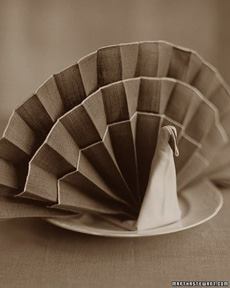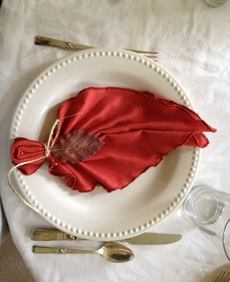|
Does someone in your family have a crafty streak? Let him or her do the napkin folding for Thankgsgiving dinner.
You can find different looks online, but we like this simple-but-elegant version from Martha Stewart. Here’s how to fold it.
Don’t wait until Thanksgiving to start folding. Test your skills and your napkins in advance. Linen napkins crease and fold well, cotton napkins and even large paper napkins work with many folds; polyester and permanent press napkins don’t fold.
THE HISTORY OF NAPKINS
How do you wipe your mouth and fingers during and after eating? Who doesn’t?
Yet, in the history of civilization, the napkins we know were relatively late to the table (as it were).
According to Food Reference and Melanie e Magdalena, it was a slow evolution, beginning with dough napkins! Ancient Spartans first used small lumps of dough to wipe their hands when eating. This led to using baked, sliced bread to wipe the hands.
Napkins slowly evolved into new forms. Note that they were the property of the well-to-do, not poor citizens who were left on their own. If you closely watch dining scenes in period television and film, you may be able to catch the custom of the time.
In Rome, the maapa, was an early tablecloth: a large cloth that covered the surface of where the individuals eating were seated. They were also used to wipe mouths and for wrapping up leftover food to take home, a custom of the host (making it the original doggy bag). Each guest supplied his own mappa.
In the Dark Ages (now called the Early Middle Ages), the napkin disappeared along with many other elements of Roman civilization. Hands and mouths were wiped on whatever was available: the back of the hand, the sleeve, or [back to pre-napkin times] a piece of bread.
During the Middle Ages, some amenities returned. Hands were wiped on tablecloths, which evolved into a three-cloth spread over the table, creating a cloth surface 4-6 feet long and 5 feet wide. You can see an example in this painting, made during between 1464 and 1467.
In the late Middle Ages, the communal napkin migrated from the table to the arms of a servant, and was reduced to the size of a modern bath towel. Over time, a basin with water for hand washing appeared. Throughout the meal, the individual would wash his hands, and the servant would drape the cloth over the diner’s arm or shoulder to dry wet hands throughout the meal. In France, a long cloth called a longiere was attached to the side of the tablecloth for communal use.
By the 16th century, the end of the Renaissance, napkins were a requirement of refined dining. A large napkin was used at the table, and a smaller napkin was used at events where people stood while eating.
By the 17th century, the standard napkin was approximately 35 inches wide by 45 inches long, a jumbo size that accommodated people who [still] ate with their fingers (today, dinner napkins are 24 x 24 inches). However, when the fork was accepted by royalty in the same century, the napkin fell from use among the aristocracy and neatness in dining was emphasized.
In the 18th century, the napkin size was reduced thanks to the widespread use of the fork by all classes of society. The napkin of the time was 30 inches by 36. Napkins followed fashion: When the fashion for men became stiffly starched ruffled collars, they were protected with napkins tied around the neck. When shirts with lace fronts came into vogue, napkins were tucked into the neck or buttonhole or were attached with a pin.
|
|

[1] A linen napkin can be creased and folded into a turkey (photo © MarthaStewart.com).

2] This leaf fold napkin from Decozilla is a lot easier [site now closed].

[3] It’s a no-brainer to create a simple harvest theme like this (photo © EcstasyCoffee.com).
|
|
Matching linens debut: Around 1740, manufacturers began making matching tablecloth and napkin sets.
Paper napkins came to the U.S. in 1887, when John Dickinson, a paper mill owner in the U.K., brought his paper napkins to a company party in the U.S.
Paper napkins didn’t take hold in the U.S. until 1931, when Scott Paper introduced its line.
Today, the napkin is made in a variety of sizes,and materials (cotton, linen, paper, polyester) and colors to meet every need:
STANDARD NAPKIN SIZES
Here are today’s standard sizes:
Cocktail napkin: 6″ x 6″
Lunch napkin: 18″ x 18″ or 20″ x 20″
Dinner napkin: 22″ x 22″ or 24″ x 24″
Buffet lap napkin: 27″ x 27″
CHECK OUT WHAT’S HAPPENING ON OUR HOME PAGE, THENIBBLE.COM.
|





